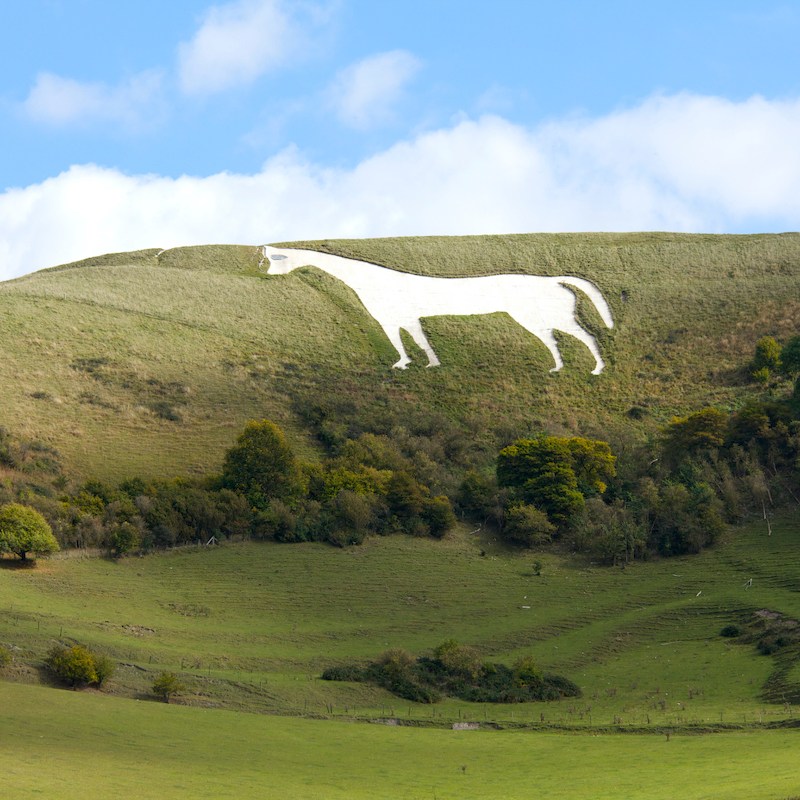
Chalk outlines, chalk figures, hill figures, and geoglyphs are all terms to describe man-made figures that, more often than not, can be found on chalk hillsides. Related figures, such as the Nazca Lines in Peru, can also be discovered on flat desertscapes.
Videos by TravelAwaits
In England, there are an estimated 50-plus hill figures, with most of them depicting horses. Some date back several thousand years, and others are quite modern. The reasons behind their creation are somewhat unclear, but certain horses are thought to have been carved by ancient peoples in celebration of won battles or royal visits.
The majority of carvings can be found in and around England’s southern counties — mostly the county of Wiltshire — likely because the southern hills are made up from chalk, making the construction of an outline so much easier.
There are various methods of creating a hill figure, with the easiest being the removal of the top layer of soil or turf from a hillside, exposing the white chalk underneath. Some figures are not carved but created by piling up white rocks, while another popular method sees ditches being carved into the ground and then filled with white rocks.
The problem with carving into the chalk underground is that nature will keep growing over the outlines. If the chalk figure is to remain, regular “grooming” is required. Over the centuries, many figures have been reclaimed by nature and lost to mankind, with only legends remaining, but there are still plenty of figures to be found on England’s green hills, making for quite an eclectic collection.
Here are some weird and wonderful, ancient and modern examples of chalk outlines in England. They can often be seen from miles away, shining bright across the green countryside, and they should be on your itinerary when visiting England next.

Uffington White Horse, Oxfordshire
The Uffington White Horse is not only the oldest chalk carving in England, dating back some 3,000 years to the Bronze Age, but it is also the only abstract depiction of a horse. Some of the figure’s lines do not join up, creating a feeling of movement. It is thought that the 360-foot-long, 130-foot-wide horse was carved on the very hill where legend has it that Saint George, the patron saint of England, slew the famous dragon. The road nearest to the carving is aptly called Dragon Hill Road.
The horse is made from trenches filled with white chalk rocks and lies surrounded by many ancient structures, such as an Iron Age hill fort and Neolithic burial mounds.
Pro Tip: Lying some 21 miles from Oxford and 81 miles from London, it is a perfect location for a day trip hiking through the ancient countryside.

Westbury White Horse, Wiltshire
Hemmed by the must-see spots of Stonehenge, Avebury, Devizes, Bath, and Salisbury, you can easily add this horse when driving the Great West Way. One of the oldest of the Wiltshire horses, at 300 years of age, it was reportedly recut in 1778 by Lord Abingdon’s steward, a certain George Gee, because the original depiction was not horse-like enough. According to old depictions, the original horse had short legs and a long, heavy body, was outfitted with a saddle, and its tail pointed upward, which, agreed, is slightly unusual. Now the horse is a chunky one, easily spotted from afar. It is believed to have been commissioned originally by King Alfred to celebrate the victory over the Danes in the Battle of Ethandium in 878AD.
Fun Fact: In case you are wondering, according to lore, the term Gee-Gee for a horse was not inspired by Mr. George Gee, even though that would have been perfect. Instead, it seems to stem from either horse racing, where the horse first out of the gates is the Gee-Gee, or from the command “gee” given to a horse.

The Long Man Of Wilmington, East Sussex
One of only two hill figures in East Sussex (the other is, of course, a horse), the 235-foot Long Man of Wilmington is also known as the Wilmington Giant. Only two hill figures in England depict humans — the other is the Cerne Giant (see below).
The Long Man of Wilmington, holding what seems to be a long stick in each hand, dates to the 1600 or 1700s, and was once cut from chalk, but has now had a more permanent make-over of white breeze blocks. Scholars are still debating its possible origin, from the figure representing a pilgrim (although that seems unlikely, as the figure is naked) to being a warrior or a Neolithic religious symbol. Either way, the figure is popular today as a gathering spot for neo-pagan revelers during pagan festivals.
The Long Man is best viewed from the south, from the public Wilmington Priory carpark.
Fun Fact: In 2020, a facemask was painted onto the Long Man’s face to mark the COVID pandemic.
Osmington White Horse, Dorset
Dating to 1808, the Osmington White Horse, etched into the limestone hills of Dorset’s Jurassic Coast, just north of Weymouth, has the distinct difference from all others in having a rider. And not just any old rider, but King George III. The 280-foot-long and 323-foot-tall figure shows King George III riding out of Weymouth. Legend has it that he took offence at being shown riding from the city, taking it as a suggestion that he was not welcome, and he never returned. The figure has received a lot of attention over the years, having been restored in 1989 for a TV show, then again, cleaned and slightly recut in 2012 for the Olympic Games, with the Queen’s daughter Princess Anne dedicating an official plaque for the horse. The previous year, some jokers added a horn to the horse, turning it into a unicorn, albeit only briefly.
Pro Tip: The horse has its own parking space, just off the A353 between Preston and Osmington, making for a perfect viewing point.

Cerne Giant, Cerne Abbas, Dorset
Just over 16 miles inland from the Osmington White Horse, you will find the other hill figure depicting a human, and quite a special human, too. The Cerne Giant’s other nickname is the Rude Man, because of his somewhat exaggerated private anatomical detail — which is 36 feet long, if you must know — and maybe even because he seems to be wielding a club. Estimated to be around 1,000 years old, the 180-foot high happy man carved into the chalk hill has throughout history been associated with a pagan ritual for fertility, which is not necessarily surprising. Yet other folklore suggests that the figure is related to a real giant that lived on the hill.
Pro Tip: Nearby, literature enthusiasts and nature lovers can combine a hike through the stunning countryside of Thorncombe Wood Nature Reserve to Thomas Hardy’s birthplace, just six miles away from Cerne Abbas.
Bulford Kiwi, Wiltshire
We’re back in Wiltshire with another chalk figure — but not a horse, nor a man, but something really unexpected for rural England: a giant kiwi bird. Carved into the chalky Beacon Hill, a handful of miles from Stonehenge, this is a truly large kiwi: 420 feet high, the beak alone being 150 long. The body covers 1.5 acres with the initials NZ carved into the hill next to the bird.
The kiwi was carved back in 1916 by New Zealand soldiers who were stationed in the nearby Bulford Camp, and who obviously wanted to leave a memento of their presence by creating their country’s national bird into the hill.
Pro Tip: The kiwi can be best viewed from Tidworth Road just past the still in existence Bulford Barracks.

Whipsnade Lion, Bedfordshire
Not a horse, nor a kiwi, but a lion adorns the hill overlooking the Dunstable Downs, between Luton and Bletchley, north of London. As is appropriate for a lion, this 483-foot geoglyph is the largest in England. Dating only to 1933, it is also one of the newer ones. And the reason behind its existence is, for once, not steeped in myth and legend but quite straightforward. The figure was commissioned to warn pilots of low flying aircraft that they were flying close to Whipsnade Zoo, the UK’s largest zoo, so they would not startle the animals. This enormous figure was such a beacon to pilots that during World War II, it had to be covered to prevent it from being used as a handy landmark by German pilots.
In 2018 the lion was re-chalked, taking 800 tonnes of chalk to restore it to its original shining white coast.
Pro Tip: You can spot the lion from the road, with both the B4540 and the B489 offering side views, but the best way to see it in all its glory is by walking along the scenic Ridgeway Long Distance footpath to the Ivinghoe Beacon.
More Tips On Seeing The Giant Chalk Figures
Unless you are incorporating any of these figures into a long-distance hike, they will not take long to visit. Yes, they are stunning and historic, and most are surrounded by scenic villages or Iron Age forts, adding extra interest, but basically, stopping at a viewpoint to take a 10-minute look at the figure and a few photos is all it takes. So it is best to incorporate them as an itinerary point on a road trip, such as the Great West Way, and take short detours to have a look.
